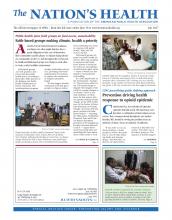For many people, a bump to the head may seem like a minor occurrence. But the fact is traumatic brain injuries caused by bumps, blows, jolts and other trauma to the head are a major cause of death and disability in the United States.
About 2.8 million emergency department visits, hospitalizations and deaths related to traumatic brain injuries occurred in the U.S. in 2013 alone, according to the Centers for Disease Control and Prevention. And such instances are on the increase, a March CDC study found.

To help prevent traumatic brain injuries in children, CDC recommends that they wear helmets while bicycling.
Photo by Dean Mitchell, courtesy iStockphoto
“Traumatic brain injuries are a serious public health problem in the United States,” said CDC in a Brain Injury Awareness Month feature in March. “Those who survive a TBI can face effects lasting a few days to disabilities which may last the rest of their lives.”
Falls are the leading cause of traumatic brain injuries, accounting for almost half of all related emergency department visits, hospitalizations and deaths. Other common causes are being struck by or against an object, assaults and motor vehicle crashes. Seniors and young children are at highest risk for traumatic brain injuries.
Fortunately, many traumatic brain injuries can be prevented. To reduce the risk of traumatic brain injuries in children, CDC recommends installing protective guards on windows, placing safety gates near stairs and using shock-absorbing surfaces on playgrounds. Children should also use helmets while riding a bike or scooter, skating, skiing, playing contact sports and during other high-risk activities.
For seniors, steps to preventing traumatic brain injuries include maintaining a regular physical activity program, removing tripping hazards, using nonslip mats and grab bars in bathrooms, installing handrails on stairways and improving lighting.
Also recommended to reduce senior falls is CDC’s Stopping Elderly Accidents, Deaths and Injuries initiative. STEADI helps health workers screen seniors for fall risk and reduce their risk of falling. Clinicians are recommended to ask their senior patients if they have fallen in the past year, feel unsteady or worry about falling; review medicines that their senior patients are taking and stop, switch or reduce medicines that increase fall risk; and recommend daily vitamin D supplements with calcium. CDC’s website offers a STEADI toolkit for health workers.
Other resources for health care providers available from CDC for preventing traumatic brain injuries include updated guidelines for diagnosis, treatment and outcomes for people with mild traumatic brain injuries. The agency also offers forms for acute concussion evaluation in patients, an online concussion training course and fact sheets and other information to share with patients.
For more details, visit bit.ly/braininjuries.
- Copyright The Nation’s Health, American Public Health Association









